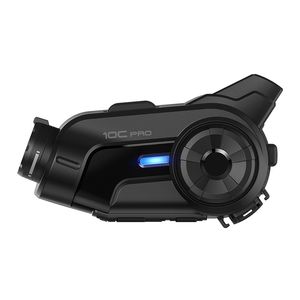Zillans who have seen Lemmy on a ride pointing at his gas tank or, worse, pointing at his nether regions and hoping Spurgeon gets the message that he needs a gas stop or a rest area break have had the same thought: There's got to be a better way.
Enter the helmet-mounted Bluetooth communication device. Like many things in the motorcycle world, these are very specialized pieces of equipment with some variation between models that’s not easily discerned just by looking at them. Knowing a few of the key differences can make purchasing one a bit simpler. Here are some answers to the most common questions we get from riders looking to upgrade from Lemmy's “universal” hand signals.
Why do I need a comm unit?
Well, that’s a good question. Though we colloquially refer to these gizmos as “comm systems,” the reality is that they do things other than function as a fancy walkie-talkie. In fact, most riders who have a comm unit are using it primarily for other functions. Because it integrates with your phone via Bluetooth, you can use your comm unit to receive directions from apps like Google Maps or Waze. (It’s pretty great to get real-time speed trap information — avoiding just one ticket might well pay for the whole setup in your lid!)
Another big plus is playing music, so you can use your favorite streaming service, or simply use downloaded material if you want to keep your data usage down. Nearly every comm system on the market has “priority” ordering, too, so you can listen to your music, but if there’s a left turn coming up, Siri will “cut in” to let you know, and your music will resume, much like your infotainment system.
Oh, yeah — your phone. You have one of those, presumably, to use for phone calls! Your Bluetooth communicator lets you make and receive calls with ease. Nearly every comm unit on the market has some form of noise-canceling technology, and the better products are astonishingly clear. It’s not at all remarkable at the time of this writing to speak with someone who has no idea you’re on a motorcycle or even on the road in any vehicle.
And, of course, you can use these to communicate with other riders. For the most part, older and cheaper comm systems at the time of this writing will connect to one another via Bluetooth, which usually can handle about four riders connected in series, and distance is limited to a few hundred feet — basically “line of sight.” This option is the most affordable, however, and though it’s less than perfect for a group of riders, it’s great for someone traveling right near you in a pack or a pillion who’s sharing the same saddle.
The more group-oriented systems use mesh networking, which is non-sequential and non-hierarchical, allowing riders to join and fall off individually without affecting the group, because each system acts like its own hub. These systems can handle well in excess of what a Bluetooth network can handle, and though they cost more, they can connect riders who are spread over much larger distances (think miles, not feet).

What’s in the box?
Usually, you’ll get the Bluetooth communicator itself, a boom microphone, a clamp or adhesive mount to affix the unit to the helmet, and some speakers. Most of the time, additional clamp kits (to mount the comm unit to your other helmets) are sold separately. (The comm unit itself usually pops on and off the clamp rapidly; so swapping from one prepped helmet to another literally takes a second or two.) Wired, low-profile adhesive mikes (as opposed the bulkier boom type) can go either way — some kits include both, others offer the low-profile mic as an optional accessory.
Will this fit my lid?
In a nutshell? Yep, it’ll fit.
There are precious few motorcycle helmets on the market that are not compatible with at least some form of communications rig. The comm designers work with helmets, and the helmet designers are aware of the comm systems. Most comm units have a base that clamps onto the lower edge of your lid if you have a full-face helmet, and a vast majority of helmets for sale today have speaker “pockets,” little cutouts to recess the speakers a bit when they’re installed so they don’t rub your ears and make you uncomfortable.

A few helmets are specifically made with a receptacle for a particular type or brand of system, which can be either a feature or a bug, depending on your point of view. (Happily, even helmets designed for a specific unit can almost all be used with a different, more universal model of communicator.)
For those of you who don’t wear a full-face, that’s OK. That boom mic we mentioned earlier works perfectly if you use a modular helmet. There are also some setups specifically designed for half- and three-quarter helmets, too! And if the idea of performing a helmet-otomy isn’t quite your speed, you can get a helmet with a built-in system. While this does narrow your options quite a bit, a helmet with an integrated unit really makes things easy: buy it, charge it, pair it up, and go ride!
If your helmet has a drop-down internal sun visor, the control may be in a similar spot to where a communicator would mount. To get around this, most riders will mount the communicator's behind the visor control.
With few exceptions, most helmets and communicators can coexist harmoniously. Buy with confidence.
Will my brand of communicator work with a different brand?
In short, yes. Almost all brands of comm systems have a provision (called “Universal Pairing Mode") to communicate with a system from another manufacturer, but some functions and features may be restricted or unavailable. Specifics vary depending on brand, model, feature, number of riders, and network style, among others, but for occasional use, you should be able to make comm units of different brands play together. That said, if you are purchasing these for either large group use or you’re going to be pairing up with the same rider consistently, you may want to give your chosen unit’s brand a bit more consideration before you purchase.
How’s the audio quality and volume?
This is pretty subjective on a few fronts. Speakers have generally improved and sound fuller and richer these days. Audiophiles may not be satisfied, however, but then the alternatives (wearing earbuds under a helmet and connected to a device or speakers blaring away from a fairing) are no better. Bass is the big problem — there’s only so much low-end oomph that can emanate from a speaker the size of a silver dollar. Upgraded speakers can be purchased from both the manufacturers and the aftermarket for those looking for the best possible sound quality.
And volume? Well, there are a lot of variables at play. Does your bike have wind protection? How quiet is your helmet? (Are your gaskets in good shape? Is your faceshield adjusted to sit snugly against them? Is your chin curtain installed?) And perhaps most importantly, how close are your speakers mounted to your ear? All of these have great effect over total volume. Even riders with poor hearing and earplugs in can usually get a properly installed comm system to power through all those obstacles and still get uncomfortably loud.
So do I need an expensive one? Or a cheap one? What’s the difference?
As with most tech items, more money gets you more features. If you want a quick run-through of what's hot for this year, we cover a few of them we think are standouts in our annual Gear Guides. Here, check 'em out!
If you just want simplex communication (listening only; think GPS and music), a set of wired speakers (like those upgrade ones from earlier) can be mounted into a helmet. Add a 3.5 mm extension cable, plug it into your phone’s auxiliary jack, and bam, you’re off to the races for under 50 bucks. But most of you reading this will likely find that setup, though economically attractive, a bit spartan.
A few more dollars gets you into a wireless solo setup. A very modestly priced step up from that is a dual-rider system, usually used for rider-rider or rider-passenger communication. (In my estimation, that’s a good “bang-for-the-buck” price break. Up to here, a little bit more money gets you a lot of useful features that almost all riders appreciate.)
At the time of this writing, there’s a bit of a chasm in price between two-rider systems and the next level up. Most of the items we just mentioned stay under the 100-buck mark per rider. From here, you’re spending quite a bit more money, and the products justify that by packing a much heftier technical punch. Right now, here are the big benefits that come with those pricier units:
- The ability to include a significantly larger number of riders on a network
- Much more range between riders and from the beginning of a group to the end
- Phone-based apps for setup and configuration rather than using on-unit buttons and voice prompts
- Superior audio quality
- Increased battery life (but also a slight increase in the size of the comm unit)
- In some cases, an integrated camera
How do I charge these?
You have a lot of options! Most of these units charge with a micro USB charger. Your unit will likely come with one, and you probably have a drawer full of them anyway. If you are using your unit for multiple days on the road and hoteling it? Just bring a powered micro USB charger. And if you’re camping in the backcountry, your battery USB charger (the Halo you stole from that guy at work) will stand you in good stead. Or, use an SAE to USB charger if you have a battery maintainer lead installed on your bike and let your motorcycle charge your comm system.
I’m having a problem. What should I do?
You can, of course, always get in touch with one of our very friendly Gear Geeks. But, if you value your time, I can give you one of the most frequent solutions we dole out: check for firmware updates. They come out all the time, and if these units are sitting in our warehouse or they’re on the Big Brown truck when one is released, you may not be running the latest and greatest bug-free software on your device. Even if you have no problems at all, a quick check on firmware updates is usually a wonderful idea, simply because features and capabilities are often improved — but to take advantage of them, you have to update the firmware!
Of course, if that doesn’t fix it (or you just want to hear us say it live!), give us a ring. We’ll get you squared up.

Do Zillans use these things?
Absolutely. They’re an integral part of the video reviews Lemmy and Spurg do and you'll see these lumps on the sides of a lot of helmets in the ZLA gear room at the office.
There's the entertainment value of listening to music and the convenience of hearing directions if you're riding alone. If you're riding with a friend, having a comm system makes the ride more fun and often safer, because you can chat about neat stuff you see along the road, alert the rider behind you to a road hazard, or discuss which greasy spoon you want to dive into for dinner. If you're riding with a passenger, it's a better way for your co-pilot to suggest a break than whacking you on the back of your helmet. And if you're riding in a big group, there's no more effective way to keep everyone together (or get everyone back together, if separated) than one of the new communicators with mesh systems.
Bluetooth communicators really do make the ride better.
















